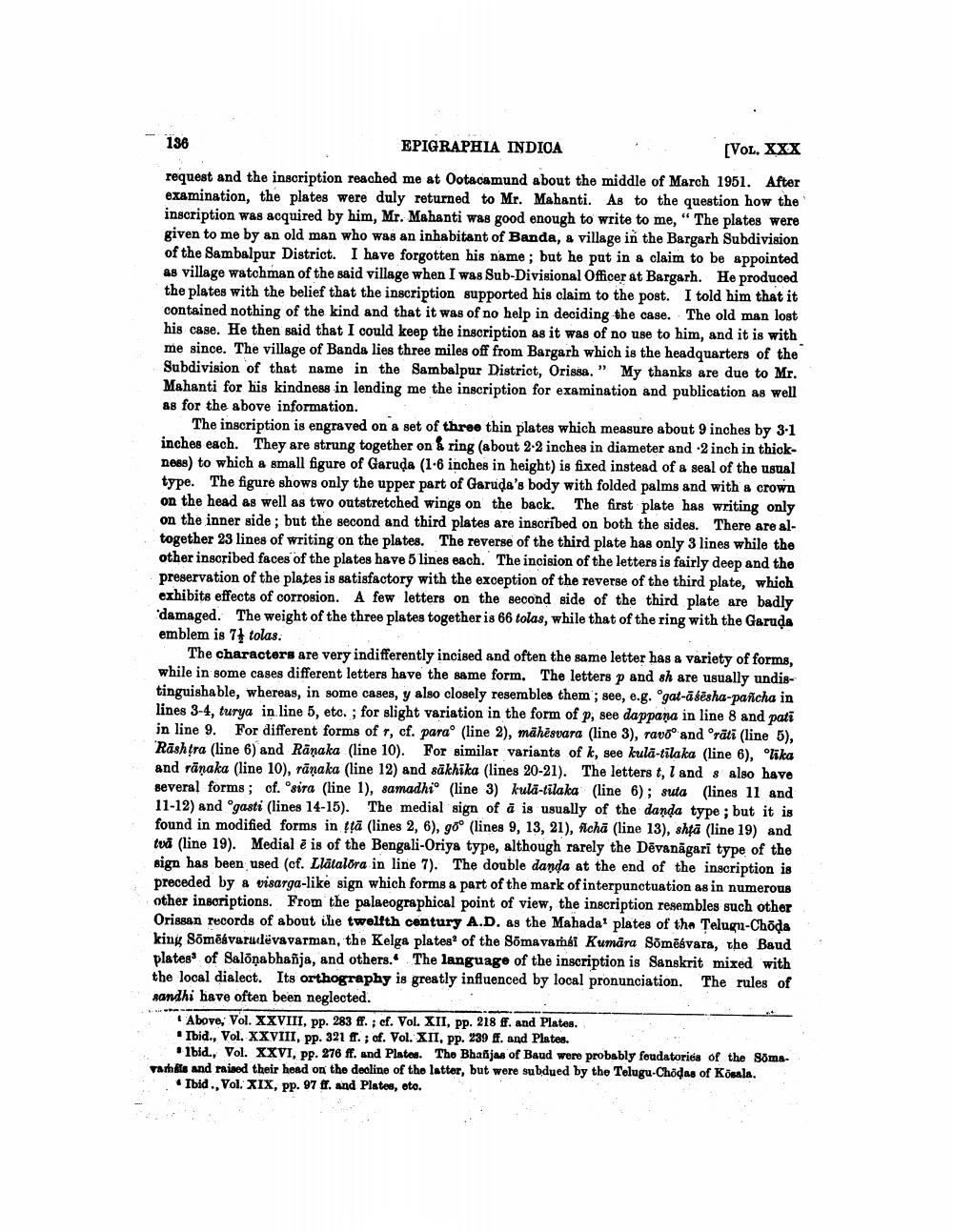________________
136 EPIGRAPHIA INDICA
[Vol. XXX request and the inscription reached me at Ootacamund about the middle of March 1951. After examination, the plates were duly returned to Mr. Mahanti. As to the question how the inscription was acquired by him, Mr. Mahanti was good enough to write to me, “ The plates were given to me by an old man who was an inhabitant of Banda, a village in the Bargarh Subdivision of the Sambalpur District. I have forgotten his name; but he put in a claim to be appointed as village watchman of the said village when I was Sub-Divisional Officer at Bargarh. He produced the plates with the belief that the inscription supported his claim to the post. I told him that it contained nothing of the kind and that it was of no help in deciding the case. The old man lost his case. He then said that I could keep the inscription as it was of no use to him, and it is with me since. The village of Banda lies three miles off from Bargarh which is the headquarters of the Subdivision of that name in the Sambalpur District, Orissa.” My thanks are due to Mr. Mahanti for his kindness in lending me the inscription for examination and publication as well 88 for the above information.
The inscription is engraved on a set of three thin plates which measure about 9 inches by 3-1 inches each. They are strung together on a ring (about 2-2 inches in diameter and 2 inch in thickness) to which a small figure of Garuda (1.6 inches in height) is fixed instead of a seal of the usual type. The figure shows only the upper part of Garuda's body with folded palms and with a crown on the head as well as two outstretched wings on the back. The first plate has writing only on the inner side; but the second and third plates are inscribed on both the sides. There are altogether 23 lines of writing on the plates. The reverse of the third plate has only 3 lines while the other inscribed faces of the plates have 5 lines each. The incision of the letters is fairly deep and the preservation of the plates is satisfactory with the exception of the reverse of the third plate, which exhibits effects of corrosion. A few letters on the second side of the third plate are badly damaged. The weight of the three plates together is 66 tolas, while that of the ring with the Garuda emblem is 71 tolas.
The characters are very indifferently incised and often the same letter has a variety of forms, while in some cases different letters have the same form. The letters p and sh are usually undistinguishable, whereas, in some cases, y also closely resembles them, see, e.g. °gat-ātesha-pancha in lines 3-4, turya in line 5, etc.; for slight variation in the form of p, see dappana in line 8 and pati in line 9. For different forms of T, cf. parao (line 2), mahēsvara (line 3), ravoo and orāti (line 5), Rashtra (line 6) and Ränaka (line 10). For similar variants of k, see kulā-tilaka (line 6), olika and rānaka (line 10), rānaka (line 12) and säkhika (lines 20-21). The letters t, 1 and 8 also have Beveral forms; of. °sira (line 1), samadhio (line 3) kulā-tilaka (line 6); suta (lines 11 and 11-12) and gasti (lines 14-15). The medial sign of a is usually of the danda type ; but it is found in modified forms in tță (lines 2, 6), goo (lines 9, 13, 21), ficha (line 13), shță (line 19) and två (line 19). Medial é is of the Bengali-Oriya type, although rarely the Devanagari type of the sign has been used (cf. Llātalora in line 7). The double danda at the end of the inscription is preceded by a visarga-like sign which forms a part of the mark of interpunctuation as in numerous other inscriptions. From the palaeographical point of view, the inscription resembles such other Orissan records of about ille twelfth century A.D. as the Mahada' plates of the Telugu-Choda king Sõmēsvaradëvavarman, the Kelga plates of the Sõmavamsi Kumāra Sõmēsvara, the Baud plates of Salónabhanja, and others. The language of the inscription is Sanskrit mixed with the local dialect. Its orthography is greatly influenced by local pronunciation. The rules of sandhi have often been neglected.
Above, Vol. XXVIII, pp. 283 ff. ; cf. Vol. XII, pp. 218 ff. and Plates. * Ibid., Vol. XXVIII, pp. 321 fl.; of. Vol. XII, pp. 239 ff. and Plates.
Ibid., Vol. XXVI, PP. 276 ff. and Plates. The Bhañijas of Baud were probably feudatories of the SomaVarhite and raised their head on the decline of the latter, but were subdued by the Telugu Chodes of Kösala.
• Ibid., Vol. XIX, pp. 97 ff. and Plates, eto.




